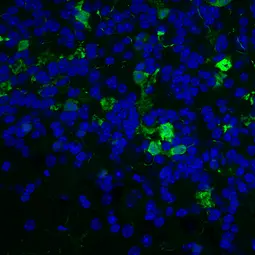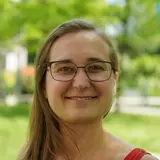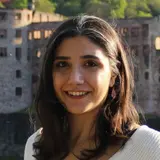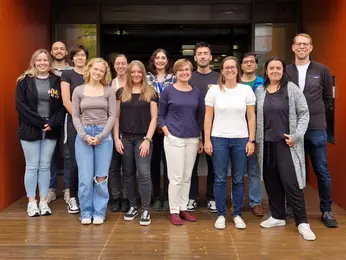Developmental Origins of Pediatric Cancer
- Functional and Structural Genomics
- KiTZ

Dr. Lena Kutscher
Emmy Noether Group Leader
Understanding the developmental basis of pediatric brain cancer is often hindered by the lack of knowledge underlying normal neural differentiation. Our research gains a deeper molecular understanding of how progenitor cells typically develop and how pediatric tumors take advantage of these programs to drive tumorigenesis. By examining pediatric tumor formation through the lens of neurodevelopment, we uncover new parallels between these processes.
Image: Unipolar brush cells of the mature cerebellum,

Image: Unipolar brush cells of the mature cerebellum,
Our Research
Pediatric cancer is the leading cause of disease-related death in children, with central nervous system (CNS) tumors being the deadliest form. Unlike adult cancers, pediatric brain cancer is thought to arise from maturation blocks during brain development. Despite its impact on children’s health, our understanding of the developmental underpinnings of pediatric brain cancer is limited. The Kutscher Lab investigates how germline and somatic alterations halt normal developmental trajectories to form (pre)malignant cells, using murine and human induced pluripotent stem cell (hiPSC) models. We are broadly interested in the genetic and molecular mechanisms underlying developmental cell death, cerebellum cell type specification, and tumor initiation. We focus on medulloblastoma, a malignant embryonal tumor arising from the developing cerebellum. Given that pediatric cancer can be thought of as a disease arising from dysregulated development, understanding both normal developmental principles and how development is altered following mutations will be key to fully understand medulloblastoma formation.
Projects
Cerebellum Development
Different subtypes of medulloblastoma arise from different progenitor cells of the cerebellum. For example, it is well-established that SHH-medulloblastoma arises from granule neuron progenitors (GNPs). Recently, we and others confirmed the unipolar brush cell (UBC) lineage as the lineage of origin for Group 3 and Group 4 medulloblastoma, based on gene expression comparisons between patient tumor samples and a single-nucleus RNA-seq atlas of the developing human cerebellum (Okonechnikov K et al, 2023, Neuro-Oncology). GNPs and UBCs arise from the same glutamatergic progenitor, but it is unknown how these cell types are specified. Therefore, we use mouse models and hiPSCs to better understand glutamatergic lineage development. Ideally, our work will identify the developmental pathways that are required for proliferation of UBC progenitors, which may then be hijacked by medulloblastoma, as well as reveal new information about human cerebellar development.
Tumor Initiation
In SHH-medulloblastoma, nearly 40% of patients have mutations in known hereditary predisposition genes. Recently, the gene ELP1 was identified as the most frequently mutated hereditary predisposition gene. ELP1 encodes the scaffolding member of the Elongator complex, which is involved in modifying tRNAs for efficient translation; how mutations in ELP1 predispose patients to tumors is unknown. Therefore, we are investigating the effect of ELP1 heterozygous mutations on GNP biology using mouse and iPSC-based cerebellar organoid models. Our future work builds upon the models we have established studying ELP1 to understand other types of hereditary predisposition and the role of germline mutations in tumor initiation. See Schloo and Kutscher 2023 for discussion of iPSC-based models of pediatric brain cancer.
Developmental Cell Death
Programmed cell death is a vital process in multicellular organism development. Although apoptosis is assumed to be the primary cell death mechanism during development, some mice lacking intrinsic apoptosis survive to adulthood, challenging this assumption. We hypothesize that the mechanism of developmental cell death called linker cell-type death (LCD), identified so far only in the nematode C. elegans (Kutscher et al 2018), exists in mammals, and is operating in parallel to apoptosis to shape early mammalian development. An H3K4 methyltransferase complex and an E3 ubiquitin ligase are implicated in LCD in C. elegans, and their human homologs are mutated in pediatric brain cancer. These shared underlie the hypothesis that perhaps mutations which hinder proper developmental non-apoptotic cell death may be in part responsible for developmental brain cancer. After identifying the genes required for normal LCD in mice, we will investigate whether these genes also have a functional role in pediatric medulloblastoma formation.
Team
The Kutscher Group is a highly collaborative, diverse and international group of scientists, technicians, and students. Interested in joining our team? Please contact Lena.
We regularly host students for internships / lab rotations / MSc thesis projects. We encourage students to contact Lena in advance, as we only have space for 1-2 students at a time. All internships are already placed for Summer / Fall 2025.
-

Dr. Lena Kutscher
Emmy Noether Group Leader
-

Laura Sieber
TA
-

Franziska Schelb
TA
-

Jana Nolle
TA
-
Dr. Patricia Benites Goncalves da Silva
Postdoc
-
Dr. Piyush Kumar Joshi
Postdoc
-

Dr. Frederik Arnskötter
Postdoc
-

Jan Vaillant
PhD student
-

Luca Bianchini
PhD student
-

Vuslat Akçay
PhD student
-

Paula Zimmer
MSc Intern
Selected Publications
Joshi P*, Stelzer T*, Okonechnikov K*, Sarropoulos I, Sepp M, Leiss K, Rademacher A, Yamada-Saito T, Bortolomeazzi M, Mallm J-P, da Silva PBG, Statz B, Wittmann A, Schramm K, Blattner-Johnson M, Fiesel P, Jones B, Milde T, Pajtler K, van Tilburg CM, Witt O, Rippe K, Korshunov A, Jones DTW, Thongjuea S, Jäger N, Kaessmann H, Pfister SM§, Kutscher LM§
Loss of Elp1 in cerebellar granule cell progenitors models ataxia phenotype of Familial Dysautonomia
Arnskötter M, da Silva PBG, Schouw ME, Lukasch C, Bianchini L, Sieber L, Garcia-Lopez J, Ahmad ST, Li Y, Lin H, Joshi P, Spänig L, Radoš M, Roiuk M, Sepp M, Zuckermann M, Northcott PA, Patrizi A, Kutscher LM
Kutscher LM*, Okonechnikov K*, Batora NV*, Clark J, Silva PBG, Vouri M, van Rijn S, Sieber L, Statz B, Gearhart MD, Shiraishi R, Mack N, Orr BA, Korshunov A, Gudenas BL, Smith KS, Mercier AL, Ayrault O, Hoshino M, Kool M, von Hoff K, Graf N, Fleischhack G, Bardwell VJ, Pfister SM, Northcott PA^, Kawauchi D^
Get in touch with us


